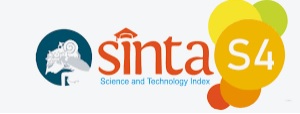Implementasi Augmented Reality Untuk Sosialisasi Dan Edukasi Tentang Flora Dan Fauna Langka Di Indonesia
Abstract
Today, there are still many people who do not know in depth the rare fauna and flora protected that characterize each region. From the lack of community literacy related to rare flora and fauna, many people do not know and are still hunting and clearing wild land in order to increase income. This research utilizes Augmented Reality technology that is intended to provide assistance to the community in obtaining information about fauna and flora that are protected in various regions.The result of this study is an Augmented Reality application using markerless method with 3D objects that can be moved freely and aims to provide information about the diverse fauna protected in Indonesia.
Keywords: Augmented Reality; Technology; Flora and Fauna;
Abstrak
Saat ini masih terdapat banyak masyarakat yang belum mengenal secara mendalam fauna dan flora langka dilindungi yang menjadi ciri khas setiap daerah. Dari kurangnya literasi masyarakat terkait flora dan fauna langka banyak masyarakat yang belum mengetahui dan masih melakukan perburuan maupun pembukaan lahan secara liar guna meningkatkan pendapatan. Pada penelitian ini memanfaatkan teknologi Augmented Reality yang ditujukan agar dapat memberikan bantuan kepada masyarakat dalam mendapatkan informasi mengenai fauna dan flora yang dilindungi di berbagai daerah. Hasil dari penelitian ini adalah sebuah aplikasi Augmented Reality menggunakan metode markerless dengan objek 3D yang dapat digerakkan secara bebas dan bertujuan untuk memberikan informasi tentang beragam fauna dilindungi di Indonesia.
Keywords
References
H. Marhaento and L. R. W. Faida, “Risiko Kepunahan Keanekaragaman Hayati di Taman Nasional Gunung Merapi: Tinjauan Spasial,” J. Ilmu Kehutan., vol. 9, no. 2, pp. 75–84, 2015, doi: 10.22146/jik.10189.
F. Hanif, “Upaya Perlindungan Satwa Liar Indonesia Melalui Instrumen Hukum Dan Perundang-Undangan,” J. Huk. Lingkung. Indones., vol. 2, no. 2, pp. 29–48, Feb. 2021, doi: 10.38011/jhli.v2i2.24.
M. Rahmawati, A. Ruslan, and D. Bandarsyah, “The Era of Society 5.0 as the unification of humans and technology: A literature review on materialism and existentialism,” J. Sosiol. Dialekt., vol. 16, no. 2, pp. 151–162, Sep. 2021, doi: 10.20473/jsd.v16i2.2021.151-162.
Luluk Mauli Diana and Evy Maya Stefany, “Pengembangan Website Administrasi Skripsi Program Studi Pendidikan Informatika,” Decod. J. Pendidik. Teknol. Inf., vol. 3, no. 2, pp. 229–235, Jun. 2023, doi: 10.51454/decode.v3i2.167.
L. Kanti, S. F. Rahayu, E. Apriana, and E. Susanti, “Analisis Pengembangan Media Pembelajaran Berbasis Augmented Reality dengan Model POE2WE Pada Materi Teori Kinetik Gas: Literature Review,” J. Pendidik. dan Ilmu Fis., vol. 2, no. 1, pp. 75–82, Jun. 2022, doi: 10.52434/jpif.v2i1.1731.
N. G. N. Estheriani and A. Muhid, “Pengembangan Kreativitas Berpikir Siswa di Era Industri 4.0 Melalui Perangkat Pembelajaran Dengan Media Augmented Reality,” Insight J. Ilm. Psikol., vol. 22, no. 2, pp. 118–129, Aug. 2020, doi: 10.26486/psikologi. v22i2.1206.
C. N. Nurdiansyah and H. Maulana, “Implementasi Augmented Reality (AR) Dengan Metode Marker Dan Markerless Pada Objek Dan Benda Bersejarah Di Museum Gedung Sate,” Univ. Komput. Indones., vol. 1, no. 2, pp. 1–8, 2018.
R. A. Lubis and H. Herlawati, “Animasi Interaktif Pengenalan Flora Dan Fauna Di Indonesia Pada SD 03 Cakung Jakarta Timur,” PIKSEL Penelit. Ilmu Komput. Sist. Embed. Log., vol. 7, no. 2, pp. 199–210, 2019, doi: 10.33558/piksel.v7i2.1841.
S. D. Riskiono, T. Susanto, and K. Kristianto, “Augmented reality sebagai Media Pembelajaran Hewan Purbakala,” Krea-TIF, vol. 8, no. 1, pp. 8–18, May 2020, doi: 10.32832/kreatif.v8i1.3369.
M. I. Akbar, E. P. Purwandari, and B. Susilo, “Implementasi Augmented Reality Flora dan Fauna Laut Kota Bengkulu berbasis Marker Tracking sebagai Media Pembelajaran Sekolah Dasar,” J. Rekursif, vol. 8, no. 2, pp. 111–122, 2020.
M. R. Zuliansyah, “Penerapan Augmented Reality Sebagai Media Pembelajaran Hewan Langka Di Lindungi Di Indonesia,” J. Inform. dan Rekayasa Perangkat Lunak, vol. 2, no. 1, pp. 1–15, 2021, doi: 10.33365/jatika.v2i4.1605.
R. S. Ritonga, Z. Syahputra, D. Arifin, and I. M. Sari, “Pengembangan Media Pembelajaran Smart Board Berbasis Augmented Reality Untuk Pengenalan Hewan Pada Anak Usia Dini,” J. PG-PAUD Trunojoyo J. Pendidik. dan Pembelajaran Anak Usia Dini, vol. 9, no. 1, pp. 40–46, 2022, doi: 10.21107/pgpaudtrunojoyo.v9i1.13418.
R. I. Borman and Y. Purwanto, “Implementasi Multimedia Development Life Cycle pada Pengembangan Game Edukasi,” J. Edukasi dan Penelit. Inform., vol. 5, no. 2, pp. 119–124, 2019.
S. Kasma, “Augmented Reality sebagai Alat Promosi Properti : Studi Kasus Pt . Fatihah Permata Propertindo di Platform Android Pendahuluan,” vol. 02, no. 01, pp. 65–74, 2024.
R. Parlika, T. A. Nisaa’, S. M. Ningrum, and B. A. Haque, “Studi Literatur Kekurangan Dan Kelebihan Pengujian Black Box,” Teknomatika, vol. 10, no. 02, pp. 131–140, 2020.
How To Cite This :
Refbacks
- There are currently no refbacks.











